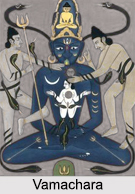Introduction
 Vamachara is a Tantric practice which does not literally mean the "left hand worship" but which the woman (Vama) enters the laya Sadhana. It is used to describe particular heterodox Tantric practices. Vama Devi is worshipped in Vamachara. During the Vamachara Sadhana, one"s energy leaves the Visuddha Chakra, goes up to the Command Centers and never comes downward. Without passing through the lower Chakras it is very difficult to arrive at these centers.
Vamachara is a Tantric practice which does not literally mean the "left hand worship" but which the woman (Vama) enters the laya Sadhana. It is used to describe particular heterodox Tantric practices. Vama Devi is worshipped in Vamachara. During the Vamachara Sadhana, one"s energy leaves the Visuddha Chakra, goes up to the Command Centers and never comes downward. Without passing through the lower Chakras it is very difficult to arrive at these centers.
Acharas in Tantra
There are two forms of acharas in Tantra - the Dakshinachara that includes the first four achara and Vamachara, including the last three acharas. It is said that the men are born into Dakshinachara and are received by the initiation into Vamachara.
Vija is the adversity and it is adverse to "Pravritti" which is governed in varying degree with the preceding achara. The path of entry is called "Nivritti". In Vamachara it is advised to directly destroy the Pravritti and to cultivate the path of Nivritti. The Pravritti is destroyed at this phase of Sadhana in such a way that passions are disconnected. Tantra does not involve lower physical desires like eating, drinking and sexual intercourse as the daily ritual. The Sadhaka must cut off all the eight bonds from the pashu.
Vamachara Tradition
The Vamachara traditions are based on worshipping the dreadful aspects of the divine, the laya pradhana, where the main aspect is dissolution. The adjournment of the follower into the ultimate supreme lord is the path of Vamachara. Vamachara tradition also involves rituals like cremation in ground, as there the "Vairagya" which is the complete detachment is available. The path of Vamachara is very dangerous to practice without the assistance of a proper Guru. The students of Vamachara Tantras are "Bramhacharis". They use their energy for healing.
Vamachara Tantra is part of an evolutionary process in consciousness which is moving towards integration with the Natural World. Nature is perceived as a sacred manifestation of the Divine where there is no separation between mind and body. Vamachara shows how one can understand what freedom is. It basically shows how one can experience the integration process. One is awakened to their own freedom and power thereby getting prepared to participate in the perpetual process of creation. Vamachara is particularly associated with Panchatattvas.
Symbolic Tradition in Vamachara
Symbolic tradition takes into account the five forbidden things such as, Maithuna, Mada, Mamsa, Matsya and Mudra as its symbols. The union of Lord Shiva and Shakti also considered as the cosmic male and female are the forces within the psyche. The inner formulation of the left handed path or the Vamachara path is always in harmony with the right handed path or the Dakshinachara. All religions contain symbolic approaches which are common in yogic traditions. The yogic tradition has never been merely attached to words, names or forms. The usage of symbolic utterances has been a common practice in yogic teachings which provides and provokes deeper inquiry within the mind.
Literal Tradition in Vamachara
Left handed tantra has a tradition of using the five forbidden things like the Maithuna, Mada, Mamsa, Matsya and Mudra as a part of its sacred rituals. The usage of these forbidden things is advocated as a preliminary practice for the people who intend to transcend body consciousness and make it as their ultimate goal. Certain intermediary steps are requires to be followed as surpassing beyond the senses is a tough goal. This is the main reason that such practices are performed in traditional Tantra. It is always difficult to renounce one`s attachments from the materialistic world. Such attachments lead to the continuous process of the cycle of birth and rebirth which is also constantly reinforced by the environment. It can be considered as an organic process of growth for the soul. According to tantrists the easiest way to transcend ones desires is to denote it as sacred and offer it to God.
The literal tradition declares that the yogic traditions have three gunas or qualities which keep the soul connected. Attachment to Tamas which is a state of darkness and dullness leads to attachment to sex and intoxicants. Attachment with Rajas which is a state of activity and turbulence lead to ones attachment with the spiritual practices and other divine matters. Finally with attachment to Sattva which means purity keeps one attached to the idea of being holy and pure. Those attached to Sattva are not actually free, instead they re trapped in the appearance of being spiritual people. Thus in such cases the tantrist teachers recommend their disciples towards the Rajasic and Tamasic path.




















